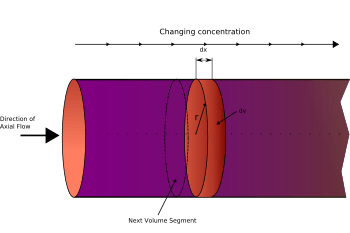Plug flow reactor model

The plug flow reactor model (PFR, sometimes called continuous tubular reactor, CTR, or piston flow reactors) is a model used to describe chemical reactions in continuous, flowing systems of cylindrical geometry. The PFR model is used to predict the behavior of chemical reactors of such design, so that key reactor variables, such as the dimensions of the reactor, can be estimated.
Fluid going through a PFR may be modeled as flowing through the reactor as a series of infinitely thin coherent "plugs", each with a uniform composition, traveling in the axial direction of the reactor, with each plug having a different composition from the ones before and after it. The key assumption is that as a plug flows through a PFR, the fluid is perfectly mixed in the radial direction but not in the axial direction (forwards or backwards). Each plug of differential volume is considered as a separate entity, effectively an infinitesimally small continuous stirred tank reactor, limiting to zero volume. As it flows down the tubular PFR, the residence time () of the plug is a function of its position in the reactor. In the ideal PFR, the residence time distribution is therefore a Dirac delta function with a value equal to .
PFR modeling
The stationary PFR is governed by ordinary differential equations, the solution for which can be calculated providing that appropriate boundary conditions are known.
The PFR model works well for many fluids: liquids, gases, and slurries. Although turbulent flow and axial diffusion cause a degree of mixing in the axial direction in real reactors, the PFR model is appropriate when these effects are sufficiently small that they can be ignored.
In the simplest case of a PFR model, several key assumptions must be made in order to simplify the problem, some of which are outlined below. Note that not all of these assumptions are necessary, however the removal of these assumptions does increase the complexity of the problem. The PFR model can be used to model multiple reactions as well as reactions involving changing temperatures, pressures and densities of the flow. Although these complications are ignored in what follows, they are often relevant to industrial processes.
Assumptions:
- plug flow
- steady state
- constant density (reasonable for some liquids but a 20% error for polymerizations; valid for gases only if there is no pressure drop, no net change in the number of moles, nor any large temperature change)
- single reaction occurring in the bulk of the fluid (homogeneously).
A material balance on the differential volume of a fluid element, or plug, on species i of axial length dx between x and x + dx gives:
- [accumulation] = [in] - [out] + [generation] - [consumption]
Accumulation is 0 under steady state; therefore, the above mass balance can be re-written as follows:
1. .[1]
where:
- x is the reactor tube axial position, m
- dx the differential thickness of fluid plug
- the index i refers to the species i
- Fi(x) is the molar flow rate of species i at the position x, mol/s
- D is the tube diameter, m
- At is the tube transverse cross sectional area, m2
- ν is the stoichiometric coefficient, dimensionless
- r is the volumetric source/sink term (the reaction rate), mol/m3s.
The flow linear velocity, u (m/s) and the concentration of species i, Ci (mol/m3) can be introduced as:
- and
On application of the above to Equation 1, the mass balance on i becomes:
2. .[1]
When like terms are cancelled and the limit dx → 0 is applied to Equation 2 the mass balance on species i becomes
3. ,[1]
The temperature dependence of the reaction rate, r, can be estimated using the Arrhenius equation. Generally, as the temperature increases so does the rate at which the reaction occurs. Residence time, , is the average amount of time a discrete quantity of reagent spends inside the tank.
Assume:
- isothermal conditions, or constant temperature (k is constant)
- single, irreversible reaction (νA = -1)
- first-order reaction (r = k CA)
After integration of Equation 3 using the above assumptions, solving for CA(x) we get an explicit equation for the concentration of species A as a function of position:
4. ,
where CA0 is the concentration of species A at the inlet to the reactor, appearing from the integration boundary condition.
Operation and uses
PFRs are used to model the chemical transformation of compounds as they are transported in systems resembling "pipes". The "pipe" can represent a variety of engineered or natural conduits through which liquids or gases flow. (e.g. rivers, pipelines, regions between two mountains, etc.)
An ideal plug flow reactor has a fixed residence time: Any fluid (plug) that enters the reactor at time will exit the reactor at time , where is the residence time of the reactor. The residence time distribution function is therefore a dirac delta function at . A real plug flow reactor has a residence time distribution that is a narrow pulse around the mean residence time distribution.
A typical plug flow reactor could be a tube packed with some solid material (frequently a catalyst). Typically these types of reactors are called packed bed reactors or PBR's. Sometimes the tube will be a tube in a shell and tube heat exchanger.
Applications
Plug flow reactors are used for some of the following applications:
- Large-scale production
- fast reactions
- Homogeneous or heterogeneous reactions
- Continuous production
- High-temperature reactions
See also
Reference and sources
- 1 2 3 Schmidt, Lanny D. (1998). The Engineering of Chemical Reactions. New York: Oxford University Press. ISBN 0-19-510588-5.